
If you aren’t very familiar with pickleball terms yet, you might be wondering: what is an erne in pickleball?
An erne is a high-level shot that isn’t commonly used. But when someone does hit an erne in pickleball, it almost always ends the rally. Thankfully, learning to do an erne isn’t that difficult.
Let’s learn more about it.
What Is an Erne in Pickleball?
In the fast-paced and strategic game of pickleball, an “erne” is a distinct and dynamic shot that requires both skill and cunning. The shot involves a player stepping out of the court and into the zone adjacent to the non-volley zone to volley a ball that’s on its way out. This move allows the player to hit the ball at a sharper angle and closer to the net than typically possible, often catching the opponents off-guard.
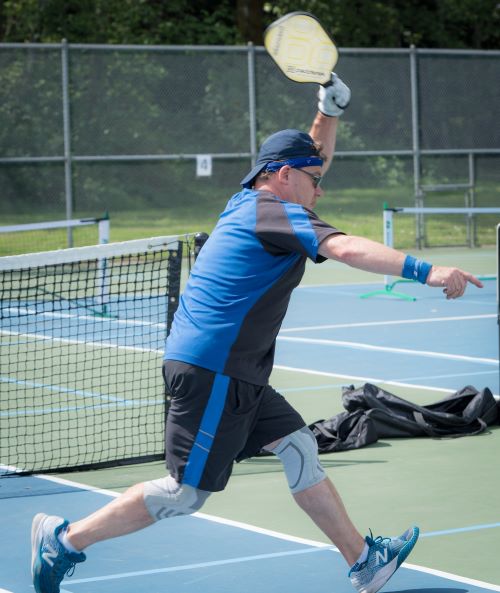
The erne is both a high-risk and high-reward move. To execute it successfully, a player needs to accurately anticipate the ball’s trajectory, time their move, and have a good sense of spatial awareness. Misjudging any of these elements can leave a player’s court vulnerable to counter-attacks. But when executed correctly, the erne can disrupt the opponents’ rhythm and control the game’s pace, providing a strategic advantage.
Why Is It Called an Erne?
Erne Perry, an avid player, frequently used this shot in his gameplay. Over time, his habitual use of the shot and his flair for pulling it off in critical moments led to it being colloquially known as the “erne”. His consistent success with the shot not only added a new dimension to his own unique style and competitive spirit, but also added a new layer of strategy and complexity to the game.
Even though Perry is largely associated with popularizing the erne, he did not invent it. The move was already employed by numerous other pickleball players before Perry adopted it as his trademark. However, Perry’s profound understanding of the shot, along with his ability to enhance its effectiveness in various game scenarios, singled him out from the rest of the players.
Who Is Erne Perry?
Erne Perry’s journey into the world of pickleball is an interesting tale. Born and raised in a small town, Perry was an athlete from a young age. He dabbled in various sports before he discovered pickleball, a sport that would soon become his passion and his life’s work. Despite not having any formal training, Perry’s dedication and love for the sport allowed him to quickly master it, leading him to local—and eventually national—competitions.
As he climbed the ranks of the pickleball world, Perry distinguished himself not only through his unique erne shot but also with his sportsmanship and ability to inspire others. Today, Perry is known as an exceptional player and a significant influencer in the sport. Even after retiring from professional pickleball competitions, Perry continues to contribute to the sport. He coaches and mentors younger players, and advocates for pickleball to be played in schools and local communities.
Perry’s name will forever be associated with the game of pickleball, not just for the shot named after him, but for his enduring impact on the sport and its community.
The Erne in Modern-day Pickleball
Fast forward to today, the erne has evolved but still carries the Perry essence. While the basic technique remains the same, players have continued to hone the shot to give it more precision, power, and unpredictability.
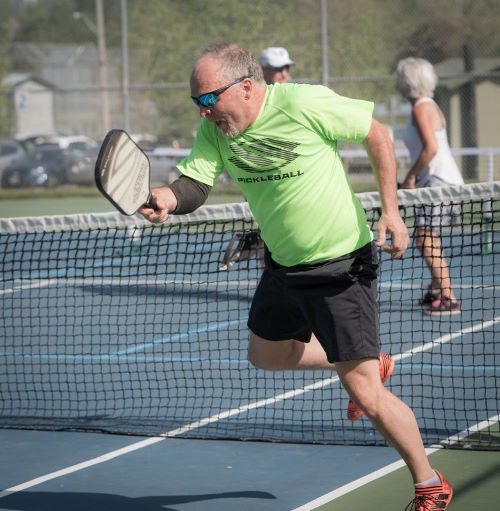
There are still no rules implemented against it, because it’s seen as a strategic shot that can swing the momentum of a game. The erne is instead viewed as a testament to Perry’s contribution to the game, symbolizing the innovative spirit of pickleball.
Different Kinds of Ernes in Pickleball
While the term “erne” is widely used within the pickleball community, it isn’t officially recognized in the sport’s rulebook. But various types of ernes have been named and used interchangeably among players, coaches, and enthusiasts, each suited to different scenarios and player styles.
Here are the different kinds of ernes in pickleball:
Smash Erne
The Smash Erne is a more aggressive variant of the shot. Players use this technique when the incoming ball is high and within reach, allowing them to hit the ball with maximum force. The aim is to make a shot so powerful and fast that it leaves the opponent with little time to react, thereby earning a point or taking control of the rally.
Soft Erne
Contrary to the Smash Erne, the Soft Erne is all about finesse and control. This type of erne is played softly, with the intention of dropping the ball just over the net. The Soft Erne forces opponents to scramble to return the shot and can be used effectively to disrupt their rhythm and pace, potentially leading to errors on their part.
Angled Erne
The Angled Erne takes advantage of the geometric possibilities of the pickleball court. This shot is played at an angle, with the aim of landing the ball on the opposite side of your opponent.
Each of these variations has its unique advantages, and mastering them can make a player exceptionally versatile and unpredictable. A player specializing in a specific type of erne can create challenges for opponents, forcing them to alter their game plan to counteract the specialized move. Whether one is a jack-of-all-trades or a master of one, the strategic use of the erne can be a game-changer in pickleball.
What Is a Bert in Pickleball?
The bert is often spoken in the same sentence as an erne, and it’s usually because they’re both played near the net and are named after pickleball players.
The term “bert” is another type of pickleball shot typically used when a player is in a tight spot. This move is best when your opponent is at the net and sends a powerful slam your way.
To do a bert in pickleball, you just hold your paddle firmly in front of your body. Angling it slightly upward and allowing the opponent’s slam to bounce off it. You’re essentially using the power of your opponent’s incoming shot to return the ball. This move requires quick reflexes and a strong understanding of angles.
As with the erne, the bert was named after a player who frequently and effectively used the move until it became associated with him. The bert serves as another reminder of how the tactics and strategies in pickleball continue to develop, shaped by the creativity and skills of its players.
Why Is an Erne a Legal Move in Pickleball?
Whether a movie is legal or not in pickleball is determined by the rules of the game. And the erne, despite its high-risk, high-reward nature, fits neatly within these boundaries. The erne is fundamentally a volley shot made from outside the court, over the non-volley zone or the kitchen. Since the player is technically not in the kitchen when making the shot, it doesn’t break any rules.
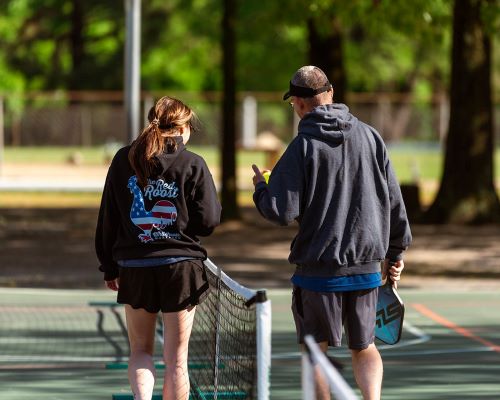
The strategic advantage of an erne lies in its ability to catch the opponent off-guard. It’s a dynamic, offensive move that allows the player to take an aggressive position and control the rally, making it an enticing option for competitive play.
However, as exciting and advantageous as the erne can be. It’s also a move that requires precision, timing, and a good sense of spatial awareness. When players step out to execute an erne, they leave a portion of their own court undefended. Potentially providing an opportunity for their opponents to exploit. But for those who have mastered the move, the rewards often outweigh the risks.
Kitchen or No Volley Zone Rules in Pickleball
The rules of the kitchen, or the non-volley zone, in pickleball are some of the most defining features of the game. The kitchen is a seven-foot area on either side of the net where volleys (shots hit without the ball bouncing) are not allowed.
If a player volleys the ball while standing in the kitchen, it’s considered a fault and the rally ends. The erne, executed outside the bounds of the court and over the kitchen, does not violate this rule, making it a legal move.
How to Hit an Erne in Pickleball?
Hitting an erne in pickleball is very challenging for beginners, but it usually boils down to how the shot is practiced.
Step 1: Figure out How Far You Can Jump
Understanding your jumping ability is crucial for executing an effective erne. The erne’s success hinges on your ability to volley the ball without landing in the kitchen, or no-volley zone. And this requires precise jumping distance. Misjudging your jump could lead to a fault, which completely undermines the strategic advantage of the erne.
Surprisingly, many players do not have an accurate sense of how far they can jump. Primarily because they don’t measure it in a game-like situation. To correctly assess your jumping distance, you should mimic the conditions of a game. Including holding a paddle above your waist and not launching from a full sprint.
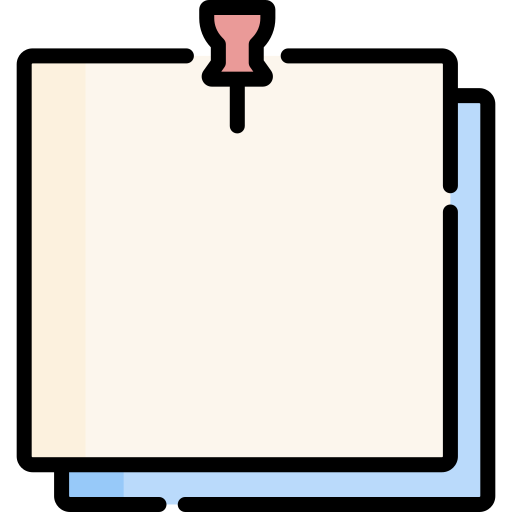
Step 2: Practice Returning Shots While Mid-Air Against a Wall
Once you have a grasp of your physical capabilities, the next step is to perfect your timing and shooting skills. Practicing against a wall is a simple yet effective way to familiarize yourself with the movements involved in an erne.
Here’s a step-by-step drill to help you get started:
- Hit the ball against the wall as you would in a normal practice session.
- Strike the ball higher or stronger, aiming for it to land just in front of you.
- As the ball descends, jump forward and make your shot while airborne.
Remember, there’s no rush to perfect this move. Start slow and small. You might initially hit the ball lightly or jump in place instead of leaping forward. Your goal is to become comfortable with the motion and timing of the erne, gradually working up to the full, powerful version of the shot.
With enough time, patience, and consistent practice, you’ll soon find yourself executing this high-risk, high-reward shot with confidence and precision.
When to Hit an Erne in Pickleball?
Hitting an erne in pickleball is situational. It’s one of those shots that only happens if the rare circumstances come together. Here are the rules of thumb you can follow:
- Is the ball going to a height that’s comfortable to hit?
- Is it almost a guarantee that your opponent can’t return the pickleball to your undefended side of the court?
- Will you make the jump to the side of the court?
What separates skilled pickleball players from beginners is their ability to create situations. In this case, skilled pickleball players expertly set up their opponents to make a mistake and provide the player with a chance to do an erne.
Here are some common situations in a pickleball match where doing an erne should win you the rally.
- Your opponent shoots a wide ball your way, near the edge of the court.
- Cross-court shots from the opponent while playing near the kitchen.
- Your opponent is stepping in the kitchen after returning a weak volley. Doing a fast erne on them before they can step out of the kitchen will be a fault for them and win you a point.
Is an Erne a Great Shot?
Yes, an erne in pickleball can definitely be a great shot! It’s a surprising, unexpected move that can easily throw your opponents off their game. The element of surprise is key in pickleball, and an erne delivers that. It’s a shot that allows players to catch a ball that is on its way out and return it from an angle that’s hard for opponents to anticipate. The high-risk, high-reward nature of this shot can really shift the momentum of a game when used at the right moment.
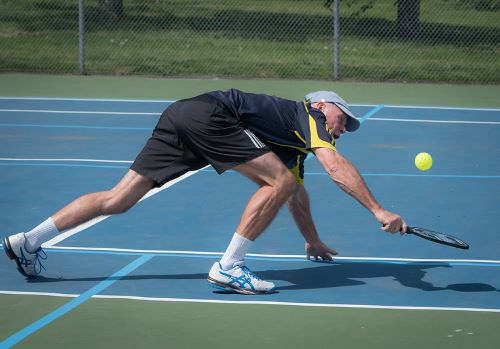
That said, the erne shot has its weaknesses, too. It requires precise judgment and a high level of skill to execute. Miss the timing, or miscalculate the distance, and your side of the court is left wide open for a counterattack.
Some players might be tempted to use the erne whenever they get the chance. Without considering whether it’s the most effective choice at that moment. The real magic of the erne shot lies in using it wisely and strategically. It’s not about the number of times you use it, but about choosing the perfect moment for maximum impact.
How to Defend Against an Erne?
Defending against an erne can be a bit tricky, but with the right approach, it’s entirely possible.
The first step in defending against an erne is recognizing when it’s about to happen. You’ll need to pay close attention to your opponent’s positioning and movement. If they start shifting towards the edge of the court while you’re about to make a wide shot, they might be preparing for an erne.
Once you anticipate an erne, it’s time to react. The best way to defend against an erne is to aim your return shot to the vacant side of the court. Remember, when a player attempts an erne, they’re leaving a large part of their court unguarded. This gives you a golden opportunity to hit a winner. Also, low and well-angled shots are harder to return with an erne. Practice these shots and you’ll have a good defense against this popular move.